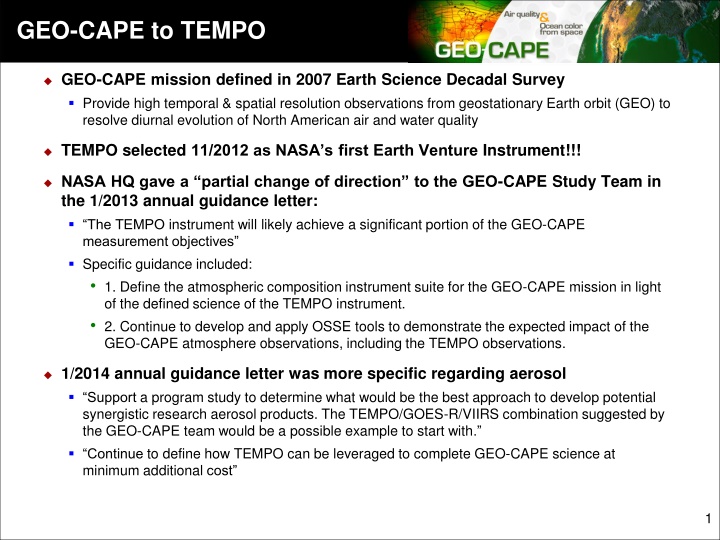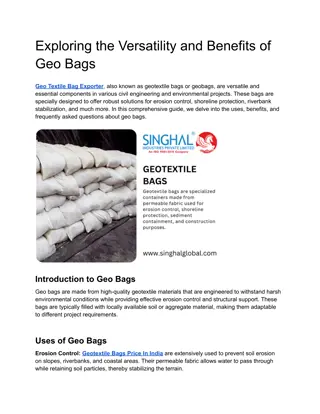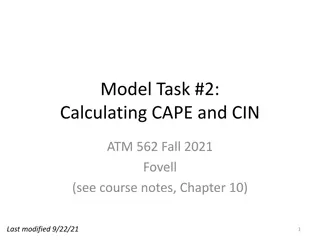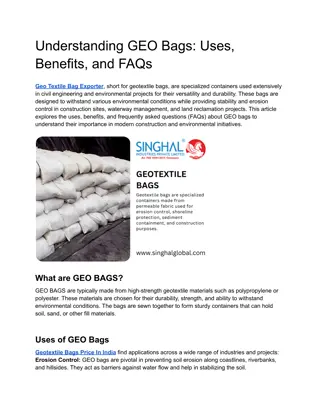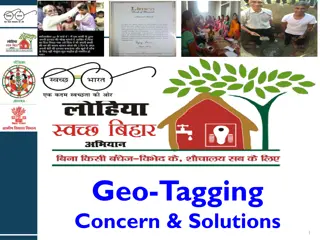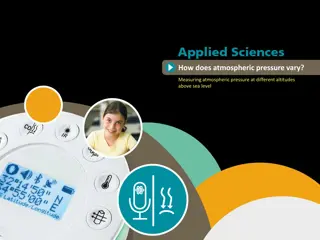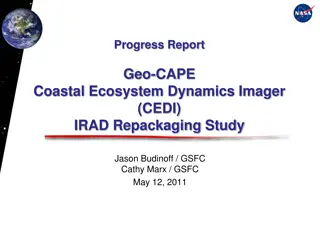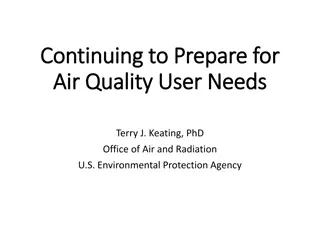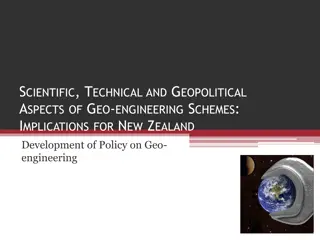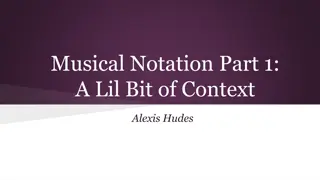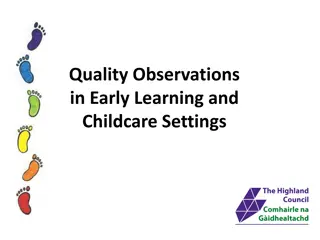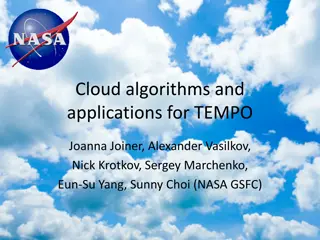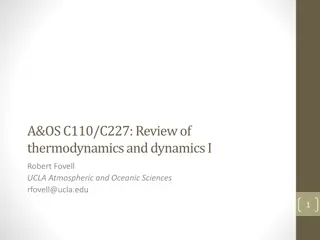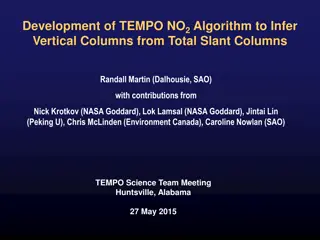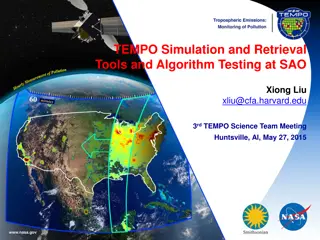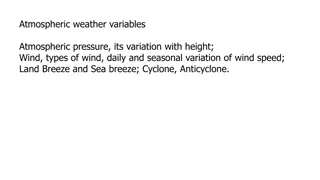Evolution of GEO-CAPE: Leveraging TEMPO for Atmospheric Observations
The GEO-CAPE mission, defined in the Earth Science Decadal Survey of 2007, aims to provide high-resolution observations from geostationary Earth orbit to monitor North American air and water quality. NASA's TEMPO instrument, selected in November 2012, plays a crucial role in achieving GEO-CAPE's objectives. However, challenges exist in meeting aerosol objectives due to TEMPO's resolution limitations. Efforts are focused on synergizing TEMPO with GOES-R for comprehensive aerosol monitoring. The GEO-CAPE team is exploring synergistic retrievals and potential missions, such as the GCIRI instrument, to enhance atmospheric science. Progress reports indicate advancements in utilizing different instruments for aerosol research, with a focus on meeting GEO-CAPE's objectives effectively.
Download Presentation

Please find below an Image/Link to download the presentation.
The content on the website is provided AS IS for your information and personal use only. It may not be sold, licensed, or shared on other websites without obtaining consent from the author.If you encounter any issues during the download, it is possible that the publisher has removed the file from their server.
You are allowed to download the files provided on this website for personal or commercial use, subject to the condition that they are used lawfully. All files are the property of their respective owners.
The content on the website is provided AS IS for your information and personal use only. It may not be sold, licensed, or shared on other websites without obtaining consent from the author.
E N D
Presentation Transcript
GEO-CAPE to TEMPO GEO-CAPE mission defined in 2007 Earth Science Decadal Survey Provide high temporal & spatial resolution observations from geostationary Earth orbit (GEO) to resolve diurnal evolution of North American air and water quality TEMPO selected 11/2012 as NASA s first Earth Venture Instrument!!! NASA HQ gave a partial change of direction to the GEO-CAPE Study Team in the 1/2013 annual guidance letter: The TEMPO instrument will likely achieve a significant portion of the GEO-CAPE measurement objectives Specific guidance included: 1. Define the atmospheric composition instrument suite for the GEO-CAPE mission in light of the defined science of the TEMPO instrument. 2. Continue to develop and apply OSSE tools to demonstrate the expected impact of the GEO-CAPE atmosphere observations, including the TEMPO observations. 1/2014 annual guidance letter was more specific regarding aerosol Support a program study to determine what would be the best approach to develop potential synergistic research aerosol products. The TEMPO/GOES-R/VIIRS combination suggested by the GEO-CAPE team would be a possible example to start with. Continue to define how TEMPO can be leveraged to complete GEO-CAPE science at minimum additional cost 1
Progress In 2013, GEO-CAPE team completed its Analysis of Alternatives given TEMPO Aerosol WG summarized status and assumptions for GEO-CAPE aerosol From the AWG studies, clear that GEO-CAPE aerosol objectives cannot be 100% met by TEMPO, mainly due to TEMPO s coarser resolution (and lack of IR band) GEO-CAPE ocean color instrument could well meet GEO-CAPE aerosol objectives in coastal regions It is unlikely we will get a dedicated GEO instrument for GEO-CAPE aerosol Therefore, we need to focus on achieving GEO-CAPE aerosol objectives by synergy between TEMPO and GOES-R GOES-R: high pixel resolution (1-km), cloud mask, good for dark target land and ocean TEMPO: will be able to get AOD over bright surface, provide AI, and obtain SSA Combo: more aerosol retrieval quantity and coverage There is also a multi-angle concept (GOES-R West TEMPO GOES-R East) to retrieve additional aerosol properties 2
Progress Possibilities identified by the GEO-CAPE Aerosol Working Group in 2013 Use GOES-R standard visible AOD product (should have similar quality as MODIS C5 DT) as a constraint for TEMPO retrieval of aerosol height and SSA (i.e. Satheesh et al. paper using MODIS AOD) Use MAIAC algorithm to perform GOES-R AOD retrieval, then use the visible AOD for TEMPO retrieval of aerosol height and SSA Joint retrieval considering UV-IR spectral range? GEO-CAPE team reported results of its Analysis of Alternatives to HQ at end of 2013 The GEO-CAPE Atmospheric Composition Instrument Suite can be clearly defined as TEMPO plus a GEO-CAPE InfraRed Instrument (GCIRI) GCIRI measurements concurrent with TEMPO will meet all GEO-CAPE science objectives at low cost High confidence GCIRI can be accomplished as EV-size mission (selectable proposals exist) Synergistic retrievals combining TEMPO, GOES-R/S, VIIRS, and other observations (PACE?) have potential to advance aerosol science even beyond GEO-CAPE goals Community considered TEMPO the first component/phase of GEO-CAPE 3
GEO-CAPE Science Treaceability Matrix (Fishman et al., BAMS, 2012) 4
GEO-CAPE STM Aerosol Requirements (Fishman et al., BAMS, 2012) Measurement Objectives Baseline: AOD, AAOD, AI, AOCH, hourly, 4km x 4km at center of domain Descope options: degrade resolution to 8km x 8km, eliminate cloud camera, eliminate AOCH, AAOD, AI Measurement Requirements Cloud Camera, 1km x 1km, two spectral bands Vertical Information Altitude +/-1km AOCH Spectral Region Vis (AOD), UV-deep blue (AAOD, AI), Vis-NIR* (AOCH) [*depending on technique eg O2- O2, O2-A, O2-B] Species Time resolution Typical Value Precision Description AOD Hourly, SZA<70 0.1 1 0.05 Observe total aerosol; aerosol sources and transport; climate forcing AAOD Hourly, SZA<70 0 0.05 0.02 Distinguish smoke and dust from non-UV absorbing aerosols; climate forcing AI Hourly, SZA<70 -1 +5 0.1 Detect aerosols near/above clouds and over snow/ice; aerosol events AOCH Hourly, SZA<70 Variable 1 km Determine plume height; large scale transport, conversions from AOD to PM 5
